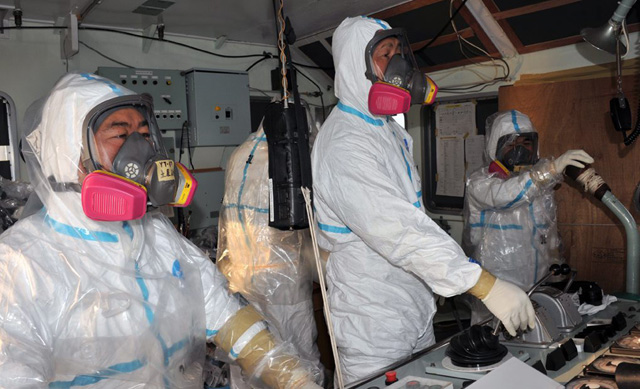Japanese workers in the nuclear power plant in Fukushima, struggling to end the nuclear crisis of the world's worst since Chernobyl, are focusing on closing a crack in a concrete well reactor 2 by the radioactivity seeping into the ocean. The operator Tokyo Electric Power (TEPCO) said he had found a crack of 20 inches that was leaking water into the reactor No.
2 nuclear plant, a measure of 1,000 mSv of radiation per hour in the air into the well. "With the increase in radiation levels in the seawater near the plant, we tried to confirm the reason and this could be the source," said Hidehiko Nishiyama, a spokesman for the Agency for Nuclear and Industrial Safety (NISA) of Japan.
But the official has warned it can not be sure to review the results. The leak has not stopped after they poured cement into the well and TEPCO now plans to use polymers that absorb water to prevent contaminated fluid reaches the sea. For now, the plant employees have been assured that revisions to the five other reactors have found no cracks.
Nishiyama said that to cool the reactor affected the NISA was reviewing alternative ways to pump water, including a makeshift air conditioning system for spraying the fuel rods from the reactor with water vapor or use the cleaning system of the plant. Until now, plant operators are far from regaining control of the damaged reactor because the fuel rods overheated and still continue to register high levels of radiation in the sea.
In addition, radiation has been detected 4,000 times the legal limit in the seawater near the plant and engineers Daiichi raised using a boat trailer to contain contaminated water. However, until you reconnect internal cooling systems of the plant still leaking radiation. Three weeks after the natural disaster that has claimed more than 27,000 dead and missing, Prime Minister of Japan, Naoto Kan, has toured the devastated coastal towns in northern Japan, giving refugees the Government's support to rebuild their homes and lifestyles.
"The government will work hard with you until the end. I want also all make their best effort," Khan asked a survivor in a shelter in the fishing village of Rikuzentakata, devastated by the tsunami that followed the earthquake of 11 March. Already unpopular before the disaster, Kan has been criticized for his handling of the nuclear and humanitarian crisis in Japan.
Some tsunami survivors have stated that the visit comes too late. Hundreds of thousands of people remain without shelter, housed in evacuation centers, while raising the death toll from the disaster. Thousands of Japanese and American soldiers have carried out this same Saturday a search for bodies, using dozens of boats and helicopters to track the areas still submerged along the northeast coast.
The teams hope that when the tide goes out this spring will be easier to find the bodies. 


2 nuclear plant, a measure of 1,000 mSv of radiation per hour in the air into the well. "With the increase in radiation levels in the seawater near the plant, we tried to confirm the reason and this could be the source," said Hidehiko Nishiyama, a spokesman for the Agency for Nuclear and Industrial Safety (NISA) of Japan.
But the official has warned it can not be sure to review the results. The leak has not stopped after they poured cement into the well and TEPCO now plans to use polymers that absorb water to prevent contaminated fluid reaches the sea. For now, the plant employees have been assured that revisions to the five other reactors have found no cracks.
Nishiyama said that to cool the reactor affected the NISA was reviewing alternative ways to pump water, including a makeshift air conditioning system for spraying the fuel rods from the reactor with water vapor or use the cleaning system of the plant. Until now, plant operators are far from regaining control of the damaged reactor because the fuel rods overheated and still continue to register high levels of radiation in the sea.
In addition, radiation has been detected 4,000 times the legal limit in the seawater near the plant and engineers Daiichi raised using a boat trailer to contain contaminated water. However, until you reconnect internal cooling systems of the plant still leaking radiation. Three weeks after the natural disaster that has claimed more than 27,000 dead and missing, Prime Minister of Japan, Naoto Kan, has toured the devastated coastal towns in northern Japan, giving refugees the Government's support to rebuild their homes and lifestyles.
"The government will work hard with you until the end. I want also all make their best effort," Khan asked a survivor in a shelter in the fishing village of Rikuzentakata, devastated by the tsunami that followed the earthquake of 11 March. Already unpopular before the disaster, Kan has been criticized for his handling of the nuclear and humanitarian crisis in Japan.
Some tsunami survivors have stated that the visit comes too late. Hundreds of thousands of people remain without shelter, housed in evacuation centers, while raising the death toll from the disaster. Thousands of Japanese and American soldiers have carried out this same Saturday a search for bodies, using dozens of boats and helicopters to track the areas still submerged along the northeast coast.
The teams hope that when the tide goes out this spring will be easier to find the bodies.



- Fukushima Disaster Worse than Worse Case 3 Reactors 70% Melted (02/04/2011)
- Energy Secretary Steven Chu Said that Fukushima Reactor 1 Core was 70% damaged and worst of crisis is behind at Fukushima (03/04/2011)
- Crack In Fukushima Structure May Be Leaking Radiation (03/04/2011)
- Nuclear Risk Expert: Fukushima Fuel May Be Leaking (02/04/2011)
- Unmanned vehicles start to be used at Fukushima reactor (19/03/2011)
No comments:
Post a Comment